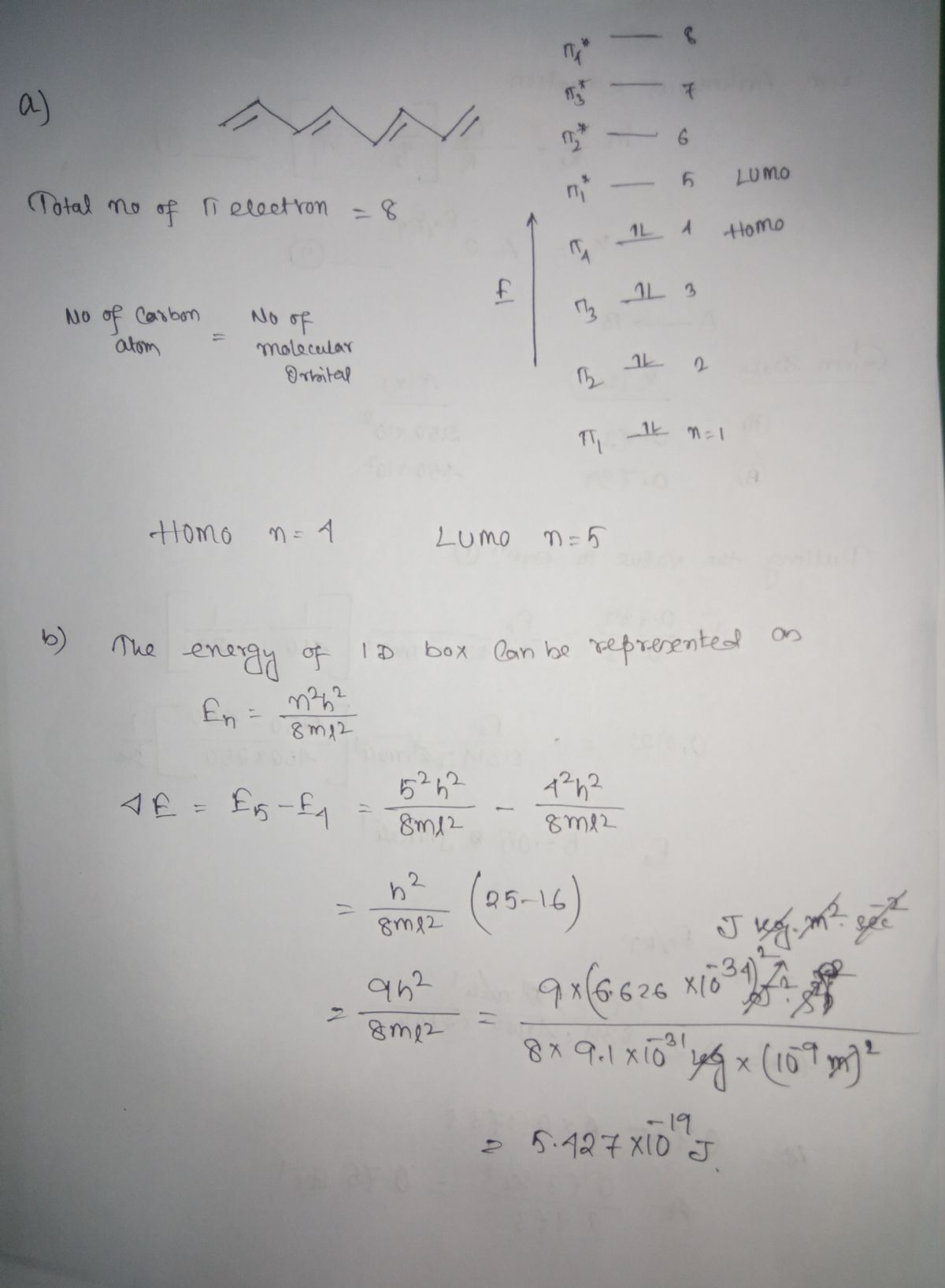eight-carbon polyene (CH2=CH-CH=CH-CH=CH-CH=CH2) can be modeled mensional particle in a box of length 1nm. at are the values of the quantum number n for the highest occupied (HOMO) and est unoccupied (LUMO) energy level based on the number of pi electrons in this ecule? LUMO n= HOMO n= lict the wavelength of light that would be absorbed in order to induce an electronic sition between the HOMO-LUMO gap. In what region of the electromagnetic =trum would this transition fall? λ =
eight-carbon polyene (CH2=CH-CH=CH-CH=CH-CH=CH2) can be modeled mensional particle in a box of length 1nm. at are the values of the quantum number n for the highest occupied (HOMO) and est unoccupied (LUMO) energy level based on the number of pi electrons in this ecule? LUMO n= HOMO n= lict the wavelength of light that would be absorbed in order to induce an electronic sition between the HOMO-LUMO gap. In what region of the electromagnetic =trum would this transition fall? λ =
Chemistry
10th Edition
ISBN:9781305957404
Author:Steven S. Zumdahl, Susan A. Zumdahl, Donald J. DeCoste
Publisher:Steven S. Zumdahl, Susan A. Zumdahl, Donald J. DeCoste
Chapter1: Chemical Foundations
Section: Chapter Questions
Problem 1RQ: Define and explain the differences between the following terms. a. law and theory b. theory and...
Related questions
Question

Transcribed Image Text:The pi electrons in an eight-carbon polyene (CH2=CH-CH=CH-CH=CH-CH=CH2) can be modeled
as a one-dimensional particle in a box of length 1nm.
a.
What are the values of the quantum number n for the highest occupied (HOMO) and
lowest unoccupied (LUMO) energy level based on the number of pi electrons in this
molecule?
HOMO n=
LUMO n=
b. Predict the wavelength of light that would be absorbed in order to induce an electronic
transition between the HOMO-LUMO gap. In what region of the electromagnetic
spectrum would this transition fall?
ΔΕ =
λ =
Expert Solution
Step 1

Trending now
This is a popular solution!
Step by step
Solved in 2 steps with 2 images

Knowledge Booster
Learn more about
Need a deep-dive on the concept behind this application? Look no further. Learn more about this topic, chemistry and related others by exploring similar questions and additional content below.Recommended textbooks for you

Chemistry
Chemistry
ISBN:
9781305957404
Author:
Steven S. Zumdahl, Susan A. Zumdahl, Donald J. DeCoste
Publisher:
Cengage Learning

Chemistry
Chemistry
ISBN:
9781259911156
Author:
Raymond Chang Dr., Jason Overby Professor
Publisher:
McGraw-Hill Education

Principles of Instrumental Analysis
Chemistry
ISBN:
9781305577213
Author:
Douglas A. Skoog, F. James Holler, Stanley R. Crouch
Publisher:
Cengage Learning

Chemistry
Chemistry
ISBN:
9781305957404
Author:
Steven S. Zumdahl, Susan A. Zumdahl, Donald J. DeCoste
Publisher:
Cengage Learning

Chemistry
Chemistry
ISBN:
9781259911156
Author:
Raymond Chang Dr., Jason Overby Professor
Publisher:
McGraw-Hill Education

Principles of Instrumental Analysis
Chemistry
ISBN:
9781305577213
Author:
Douglas A. Skoog, F. James Holler, Stanley R. Crouch
Publisher:
Cengage Learning

Organic Chemistry
Chemistry
ISBN:
9780078021558
Author:
Janice Gorzynski Smith Dr.
Publisher:
McGraw-Hill Education

Chemistry: Principles and Reactions
Chemistry
ISBN:
9781305079373
Author:
William L. Masterton, Cecile N. Hurley
Publisher:
Cengage Learning

Elementary Principles of Chemical Processes, Bind…
Chemistry
ISBN:
9781118431221
Author:
Richard M. Felder, Ronald W. Rousseau, Lisa G. Bullard
Publisher:
WILEY